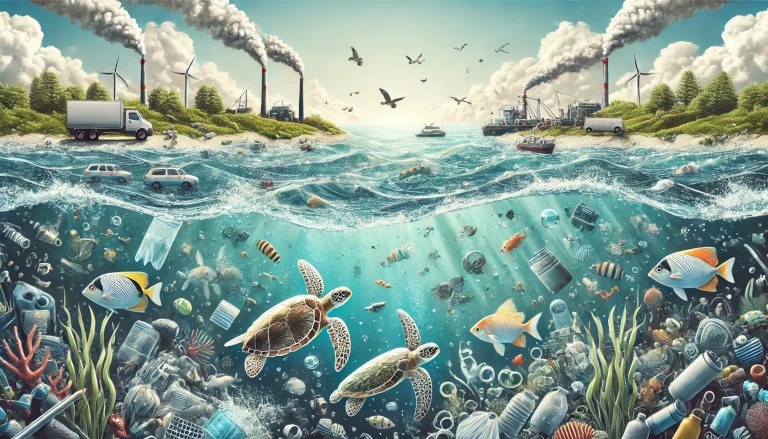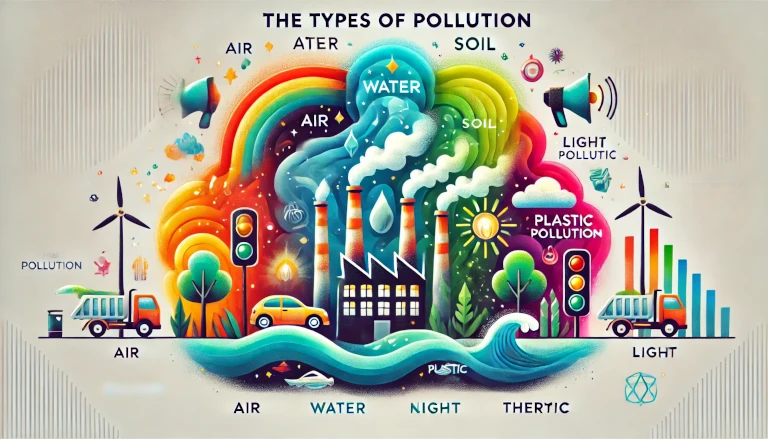Aquatic pollution refers to the contamination of water bodies like rivers, lakes, oceans, and groundwater due to human activities. This contamination has far-reaching impacts on ecosystems, marine life, human health, and the global economy. The pollutants often come from industrial waste, agricultural runoff, plastic debris, and untreated sewage, among others. Addressing aquatic pollution is crucial for the sustainability of aquatic environments and the well-being of life on Earth.
What is Aquatic Pollution? 🌊
Aquatic pollution occurs when harmful substances such as chemicals, plastic waste, and biological contaminants enter water bodies, degrading the water quality and making it harmful for humans, animals, and plants.
Why is Aquatic Pollution a Major Concern? ⚠️
Aquatic ecosystems are vital for biodiversity, climate regulation, and as sources of food and livelihoods for millions of people. Pollution not only harms marine life but also disrupts the balance of ecosystems and can lead to the extinction of species. Moreover, aquatic pollution affects drinking water, food safety, and tourism, making it a global environmental and economic concern.
How Does Aquatic Pollution Occur? 🌍
Aquatic pollution is caused by various human activities:
- Industrial Waste: Factories often discharge harmful chemicals directly into rivers, lakes, and oceans without proper treatment.
- Agricultural Runoff: The use of fertilizers and pesticides leads to nutrient pollution in water bodies, causing algal blooms and oxygen depletion.
- Plastic Pollution: Millions of tons of plastic waste end up in oceans each year, posing a threat to marine life.
- Oil Spills: Accidents during oil drilling and transportation can lead to massive oil spills that destroy marine ecosystems.
Where is Aquatic Pollution Most Severe? 🌎
Aquatic pollution is most severe in areas with high industrial and agricultural activity, densely populated regions, and along coastlines. Major polluted areas include:
- Oceans: The Pacific Garbage Patch is a stark example of plastic pollution.
- Rivers and Lakes: Rivers like the Ganges in India and the Mississippi in the U.S. face severe pollution from industrial waste and runoff.
- Coastal Areas: Coastal regions with high tourism and industrial development face increased levels of water pollution due to improper waste management.
When Did Aquatic Pollution Become a Major Problem? 📅
While pollution has always existed in some form, the rapid industrialization and urbanization of the 19th and 20th centuries exacerbated the problem. The increase in chemical use, the rise in plastic production, and the growth of human populations have all contributed to making aquatic pollution a major global issue in the last century.
How Much Does Aquatic Pollution Cost? 💸
The costs of aquatic pollution are enormous:
- Environmental Costs: Degraded ecosystems lead to biodiversity loss and the destruction of aquatic habitats.
- Economic Costs: Pollution affects industries like fisheries and tourism, costing billions of dollars globally. The UN estimates that plastic pollution alone causes around $13 billion in economic damage annually.
- Health Costs: Contaminated water leads to diseases and health conditions, increasing healthcare costs for affected populations.
Advantages of Combating Aquatic Pollution 🌱
- Improved Biodiversity: Reducing pollution helps restore natural habitats and supports the survival of various species.
- Cleaner Water Supplies: Decreasing water pollution ensures safer drinking water for populations.
- Economic Growth: Cleaner water bodies boost tourism, fishing, and other water-related industries.
- Healthier Communities: By preventing waterborne diseases, efforts to reduce aquatic pollution improve public health outcomes.
Disadvantages of Ignoring Aquatic Pollution ⚖️
- Ecosystem Destruction: Continuous pollution leads to the death of marine life and destroys fragile ecosystems.
- Economic Decline: Industries dependent on clean water, such as fisheries and tourism, suffer significant losses due to polluted water bodies.
- Health Risks: Polluted water increases the risk of diseases such as cholera, dysentery, and hepatitis, particularly in developing countries.
Cost Benefits of Reducing Aquatic Pollution 💰
Investing in reducing aquatic pollution has several cost benefits:
- Lower Healthcare Costs: Cleaner water leads to fewer pollution-related health issues, reducing healthcare spending.
- Economic Growth: Sustainable fishing, tourism, and other industries thrive when water bodies are clean.
- Environmental Restoration: Healthy aquatic ecosystems provide essential services such as carbon sequestration, contributing to efforts against climate change.
Solutions to Aquatic Pollution 🌍
- Improved Waste Management: Proper disposal of industrial, plastic, and agricultural waste can reduce contamination.
- Strict Regulations: Governments must enforce stricter regulations on waste disposal and emissions into water bodies.
- Cleaner Production Methods: Promoting the use of eco-friendly chemicals and biodegradable materials can help reduce the amount of toxic waste entering water bodies.
- Public Awareness: Educating people about the importance of keeping water clean and the impact of pollution is crucial for long-term change.
The Urgent Need to Address Aquatic Pollution 🐟
Aquatic pollution poses a severe threat to the environment, public health, and global economies. By understanding its causes, effects, and solutions, we can take action to reduce pollution and protect our water resources for future generations. Governments, businesses, and individuals must work together to combat aquatic pollution and promote sustainable water management.
Aquatic pollution is a growing concern worldwide. Understanding its causes, effects, and solutions is key to protecting the environment and supporting sustainable ecosystems. 🌍
Discover more from Green Ecosystem - Renewable Energy, Agriculture, and Environmental Sustainability
Subscribe to get the latest posts sent to your email.


